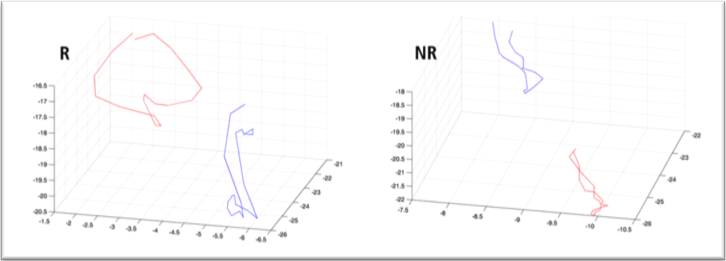TRAJECTORY “Trajectory changes of coronary sinus lead tip and cardiac resynchronization therapy outcome”
Prediction of response to cardiac resynchronization therapy (CRT) is still an unsolved major issue. Apart from identifying dyssynchrony areas best suitable for LV pacing by considering the latest activated LV segments, no studies have developed any reliable, real-time, repeatable intra-operative assessment of the acute effect of biventricular (or LV) pacing on LV mechanics, in different site placements of coronary sinus (CS) lead. In fact, no currently available technique could be used as an intra-operatory guidance to pacing site selection, on the basis of any measurable electrical or mechanical pacing-driven effect which could consistently predict resynchronization. Our group developed a method, published in Med & Biol Eng Comp in 2011, to investigate movements of the electrode distal tip inside CS branch throughout the cardiac cycle, by reconstructing in 3D space the instantaneous lead tip’s geometric trajectory, on the basis of a few seconds fluoroscopic recordings. The geometrical properties of the trajectory’ shape were assessed in a single-center, prospective non-randomized clinical study, published in Heart Rhythm in 2013. That preliminary study performed on a small sample (22 patients) showed that biventricular pacing acutely induced changes in trajectory which, in responders only, appeared to be more distributed along multiple directions in 3D space, pointing towards a more circular shape. Non-responders’ trajectories exhibited no variation or a further decrease in their “circularity”. Results were interesting and “pathophysiological hypothesis-generating”, but they need to be reproduced on a larger, multi-centric scale. In this proposed observational prospective study we aim to assess whether variations in CS lead tip trajectory acutely induced by acute biventricular pacing are predictive of volumetric and clinical response to CRT at six-month follow-up, in a larger population. Secondary objective is to evaluate, in a subgroup of patients receiving a quadripolar CS lead, the trajectories’ changes acutely induced by biventricular pacing with different pacing electrodes at the final lead location, and whether they can be used as guidance to select the best LV vector for pacing.
- Santa Maria delle Croci Hospital, Ravenna
- Santa Maria delle Croci Hospital, Ravenna
- Bufalini Hospital, Cesena
- Sant’Orsola-Malpighi University Hospital, Bologna

Related publications
- C. Tomasi, C. Corsi, D. Turco, S. Severi, An exploratory study on coronary sinus lead tip trajectory changes in cardiac resynchronization therapy, Heart Rhythm, 10(9):1360-1367, 2013.
- C. Corsi, C. Tomasi, D. Turco, M. Margheri, C. Lamberti, S. Severi, 3D Dynamic Position Assessment of the Coronary Sinus Lead in Cardiac Resynchronization Therapy, Medical and Biological Engineering and Computing, 49:901–908, 2011.
- C. Corsi, D. Turco, C. Tomasi, M. Margheri, C. Lamberti, S. Severi, Prediction of Cardiac Resynchronization Therapy Response by Means of 3D Trajectory Assessment of the Coronary Sinus Lead, Computing in Cardiology 2012 (Krakow, Poland, September 9-12, 2012), edited by Alan Murray, IEEE Press, Vol. 39:533.536, 2012.
- C. Corsi, F. Veronesi , M. Mosconi, M.C. Tomasi, S. Severi, M. Margheri, C. Lamberti, Coronary sinus lead tracking for its 3D dynamic position assessment in cardiac resynchronization therapy, Computers in Cardiology 2009 (Park City, UT, USA, September 13-16, 2009), edited by Alan Murray, IEEE Press, Vol. 36:641-644.


